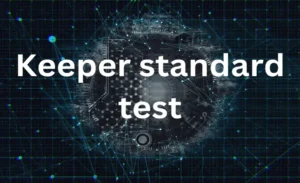Artificial intelligence
Keeper Standards Test: Evaluating AI Reliability and Ethics

The advancement of artificial intelligence (AI) has revolutionized industries, reshaped economies, and redefined the ways in which societies interact with technology. However, as this transformation continues, the critical question remains: how do we ensure that AI systems operate reliably and ethically? To address this challenge, the concept of the “Keeper Standards Test” has emerged as a comprehensive framework for evaluating AI systems against stringent benchmarks of reliability and ethical performance. This article delves into the essence of the Keeper Standards Test, exploring its components, significance, and implications for the future of AI development.
The Necessity of Ethical and Reliable AI
AI systems are increasingly integrated into critical sectors such as healthcare, law enforcement, finance, and transportation. With such integration comes immense responsibility. An unreliable AI system in a self-driving car, for instance, could result in fatal accidents, while an unethical AI in judicial systems could perpetuate biases and injustices. The Keeper Standards Test addresses these concerns by establishing a rigorous evaluation mechanism that prioritizes safety, fairness, and accountability.
One of the primary motivators behind the development of the Keeper Standards Test is the growing public concern over AI transparency and accountability. The opaque nature of many AI algorithms often makes it challenging to determine how decisions are made, leading to a trust deficit among users. By incorporating mechanisms to measure interpretability and fairness, the Keeper Standards Test aims to bridge this gap, fostering greater trust in AI applications.

Core Components of the Keeper Standards Test
The Keeper Standards Test is built on several foundational pillars designed to assess AI systems comprehensively. Each component focuses on a specific aspect of AI performance, ensuring a holistic evaluation.
- Reliability and Robustness
- AI systems must demonstrate consistent performance across diverse scenarios. This includes handling edge cases, unexpected inputs, and environmental variations without failure.
- Stress testing and simulation-based evaluations form a core part of assessing reliability.
- Ethical Adherence
- AI systems must align with ethical principles such as fairness, non-discrimination, and respect for privacy.
- Evaluators analyze data sets and decision-making processes to ensure the absence of inherent biases.
- Transparency and Explainability
- AI decisions should be understandable to stakeholders, including non-technical users.
- Tools such as interpretable machine learning models and visual explanations are utilized to enhance transparency.
- Compliance with Legal Standards
- AI systems must adhere to global and local regulations, including data protection laws and ethical guidelines.
- Regular audits and certifications ensure compliance with evolving legal frameworks.
- Human-Centric Design
- AI should prioritize user safety and well-being, incorporating feedback mechanisms to address concerns and improve functionality.
- This includes designing user-friendly interfaces and providing recourse for resolving disputes.
Practical Implementation of the Keeper Standards Test
Implementing the Keeper Standards Test requires collaboration among developers, regulators, and independent evaluators. Developers play a pivotal role in designing AI systems that align with the test’s criteria. From the initial stages of model training to deployment, adhering to Keeper Standards principles ensures that AI systems remain reliable and ethical.
Regulators, on the other hand, establish the legal and procedural frameworks that govern AI evaluations. These frameworks include guidelines for data usage, accountability mechanisms for decision-making, and penalties for non-compliance. Independent evaluators act as neutral parties, conducting assessments and issuing certifications based on Keeper Standards criteria.
A significant aspect of practical implementation involves continuous monitoring. Unlike traditional software, AI systems evolve over time, often requiring retraining and updates. Continuous monitoring ensures that these changes do not compromise the system’s reliability or ethical adherence. Moreover, periodic reassessments help maintain the relevance of evaluations as AI applications adapt to new challenges and opportunities.
Challenges in Evaluating AI Reliability and Ethics
While the Keeper Standards Test provides a robust framework, its implementation is not without challenges. One of the primary hurdles is the lack of standardized metrics for assessing AI ethics. What constitutes fairness or bias can vary significantly across cultures, industries, and individual perspectives. Addressing this requires a nuanced approach that balances universal ethical principles with context-specific considerations.
Another challenge lies in the complexity of AI systems. Modern AI models, such as deep learning networks, often operate as “black boxes,” where the internal decision-making processes are difficult to interpret. Developing tools and methodologies to enhance explainability remains a critical area of research.
Moreover, the Keeper Standards Test must navigate the rapid pace of AI innovation. As new technologies emerge, the test’s criteria must evolve to address novel risks and ethical dilemmas. This requires a dynamic and flexible framework that can adapt without compromising its core principles.
Case Studies: Keeper Standards Test in Action
To illustrate the impact of the Keeper Standards Test, consider its application in healthcare. An AI-powered diagnostic tool designed to identify diseases from medical imaging must be both reliable and ethical. By undergoing the Keeper Standards Test, the tool is evaluated for accuracy across diverse patient demographics, ensuring that it does not favor certain groups over others. Additionally, its decision-making process is made transparent, enabling medical professionals to understand and trust its recommendations.
In another example, the Keeper Standards Test is applied to an AI-based hiring platform. Such systems often face criticism for perpetuating biases present in historical hiring data. Through rigorous evaluation, the test identifies and mitigates these biases, ensuring fair and inclusive recruitment practices. The platform’s compliance with legal standards further enhances its credibility among users and stakeholders.

The Role of Stakeholders in Ensuring AI Accountability
The success of the Keeper Standards Test hinges on the active participation of stakeholders from various domains. Policymakers and regulators must create an enabling environment for ethical AI by enacting supportive laws and incentivizing compliance. AI developers and researchers should prioritize ethical considerations throughout the development lifecycle, integrating Keeper Standards principles into their workflows.
Users and advocacy groups also play a crucial role. By demanding greater transparency and accountability, they can drive industry-wide adoption of the Keeper Standards Test. Public awareness campaigns and educational initiatives can empower individuals to make informed decisions about AI usage, further strengthening trust in these technologies.
A Vision for the Future of Ethical AI
As AI continues to reshape the world, the Keeper Standards Test represents a beacon of hope for ensuring that these transformative technologies serve humanity’s best interests. By establishing clear benchmarks for reliability and ethics, the test provides a roadmap for developing AI systems that are not only technologically advanced but also socially responsible.
In the long term, the Keeper Standards Test could become a global standard, harmonizing AI evaluation practices across countries and industries. Such harmonization would facilitate international collaboration, enabling stakeholders to address shared challenges and leverage AI’s potential for collective benefit.
Conclusion
The Keeper Standards Test stands as a cornerstone for fostering trust and accountability in the rapidly advancing world of artificial intelligence. By providing a structured approach to evaluating AI systems, it ensures that technological innovations align with societal values and ethical principles. The emphasis on reliability, transparency, and ethical adherence transforms the Keeper Standards Test into more than a benchmark; it becomes a commitment to creating AI that serves humanity responsibly.
As we continue to integrate AI into the fabric of daily life, the Keeper Standards Test will be pivotal in shaping a future where AI technologies are not only powerful but also trustworthy and inclusive. Collaboration among developers, regulators, and users will be key to realizing this vision, enabling AI to reach its full potential without compromising on reliability or ethics. In this way, the Keeper Standards Test ensures that AI remains a force for good, driving progress while safeguarding human dignity and fairness.
FAQs:
What is the Keeper Standards Test?
The Keeper Standards Test is a comprehensive framework designed to evaluate the reliability, ethical adherence, and transparency of AI systems. It sets benchmarks to ensure AI operates safely, fairly, and responsibly across various applications.
Why is the Keeper Standards Test important?
The test addresses critical concerns about AI reliability and ethics by establishing clear criteria for evaluating AI systems. It helps build public trust and ensures that AI technologies align with societal values and legal standards.
Who benefits from the Keeper Standards Test?
Stakeholders such as developers, regulators, businesses, and end-users benefit from the Keeper Standards Test. It ensures that AI systems are safe, ethical, and effective, fostering trust and accountability.
How is the Keeper Standards Test implemented?
The test involves collaboration among developers, regulators, and independent evaluators. It includes continuous monitoring, stress testing, and compliance checks to ensure AI systems meet the required benchmarks.
What challenges does the Keeper Standards Test address?
The test tackles issues like AI biases, lack of transparency, and rapid technological advancements. By setting dynamic and adaptive evaluation criteria, it addresses ethical dilemmas and reliability concerns.
Can the Keeper Standards Test be applied globally?
Yes, the test has the potential to become a global standard, harmonizing AI evaluation practices across countries and industries. This would facilitate international collaboration and shared progress in AI development.

-

 Blog8 months ago
Blog8 months agoDiscover The World Of Movies With Mkvcinemas.com
-

 Biography9 months ago
Biography9 months agoMadeline Argy: Age, Height, and Family Background Revealed
-

 Tech9 months ago
Tech9 months agoSimpCityForum: One of the Most Interesting Online Communities
-

 Biography9 months ago
Biography9 months agoCelebrityMeet Christina Erika Carandini Lee?: All You Need To Know
-

 Biography8 months ago
Biography8 months agoMary Marquardt: The Woman Behind Harrison Ford’s Rise
-

 Biography9 months ago
Biography9 months agoHow Old Is SZA Daughter? Discover SZA Daughter’s Age, Name, and More
-

 Crypto Currency9 months ago
Crypto Currency9 months ago5starsstocks .com: How It’s Useful and Helpful
-

 Blog9 months ago
Blog9 months agoWhat is FilthyGrid? Exploring the World of FilthyGrid
-

 Health & Fitness9 months ago
Health & Fitness9 months agoWhat Has Kiolopobgofit in It? Exploring the Enigmatic Concept
-

 Biography9 months ago
Biography9 months agoChevy Chase Net Worth, Bio, Age, Height, Wife & Family
